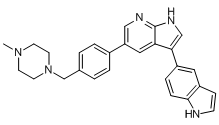All AbMole products are for research use only, cannot be used for human consumption.

URMC-099 is an orally bioavailable, potent mixed lineage kinase type 3 (MLK3) inhibitor with IC50 of 14 nM, which has excellent blood-brain barrier penetration properties. The effect of URMC-099 (URMC099) on tumor formation in vivo is analyzed using a well characterized mouse xenograft model of breast cancer brain metastasis. For these experiments, eGFP8.4 cells are inoculated into the left ventricle of immunodeficient nu/nu mice; animals are then treated with either URMC-099 (10 mg/kg) or vehicle alone, every 12 hours for 20 days. This dose of URMC-099 is chosen because it has been shown to be sufficient to effectively inhibit MLK3 in mice, with good penetration of the blood-brain barrier and potent inhibition of the phosphorylation of Jun N-terminal kinase (JNK) in brain tissue. On day 21 the mice are sacrificed and number of BM is assessed. Fifteen mice are used for each treatment group. BM are detected in 60% of mice, which is consistent with previous studies using this xenograft model by other investigators. URMC-099 treatment significantly (p<0.05, two-tailed t-test) increases the total number of brain metastasis (BM) in mice.
| Molecular Weight | 421.54 |
| Formula | C27H27N5 |
| CAS Number | 1229582-33-5 |
| Solubility (25°C) | DMSO ≥ 25 mg/mL |
| Storage |
Powder -20°C 3 years ; 4°C 2 years In solvent -80°C 6 months ; -20°C 1 month |
| Related Products |
|---|
| Myoglobin (from equine skeletal muscle)
Myoglobin is a small molecular pigment protein formed by binding globin to Heme, which can be reversibly bound to oxygen to form MbO2, MbO2 is called oxymyoglobin, and Mb is called deoxymyoglobin. Myoglobin has the role of transporting and storing oxygen in muscle cells. |
| Hemoglobin (from bovine blood)
Hemoglobin is a iron-containing protein in red blood cells with oxygen binding properties. Hemoglobin is an inducer of HO-1. Hemoglobin consits of heme, which binds to oxygen. Hemoglobin also transports other gases, such as carbon dioxide, nitric oxide, hydrogen sulfide and sulfide. |
| Diethylenetriaminepentaacetic dianhydride
Diethylenetriaminepentaacetic dianhydride (DTPA anhydride) is a bifunctional chelator whose anhydride can react with amino groups in proteins (such as lysine residues) to form stable amide bonds. Diethylenetriaminepentaacetic dianhydride (DTPA anhydride) can also bind to radionuclides to synthesize radionuclide-labeled drug conjugates (RDCs). |
| 3-Phenylthiophene
3-Phenylthiophene is a biochemical material that can be used in scientific research. 3-Phenylthiophene is a conducting polymer precursor. |
| DSPE-PEG-FA
DSPE-PEG2K-FA is a PEG derivative containing folic acid. DSPE-PEG2K-FA has a targeting effect and can bind to folic acid receptors in cancer cells. DSPE-PEG2K-FA forms micelles/lipid bilayers and can be used in research on targeted drug delivery systems. |
All AbMole products are for research use only, cannot be used for human consumption or veterinary use. We do not provide products or services to individuals. Please comply with the intended use and do not use AbMole products for any other purpose.


Products are for research use only. Not for human use. We do not sell to patients.
© Copyright 2010-2024 AbMole BioScience. All Rights Reserved.
